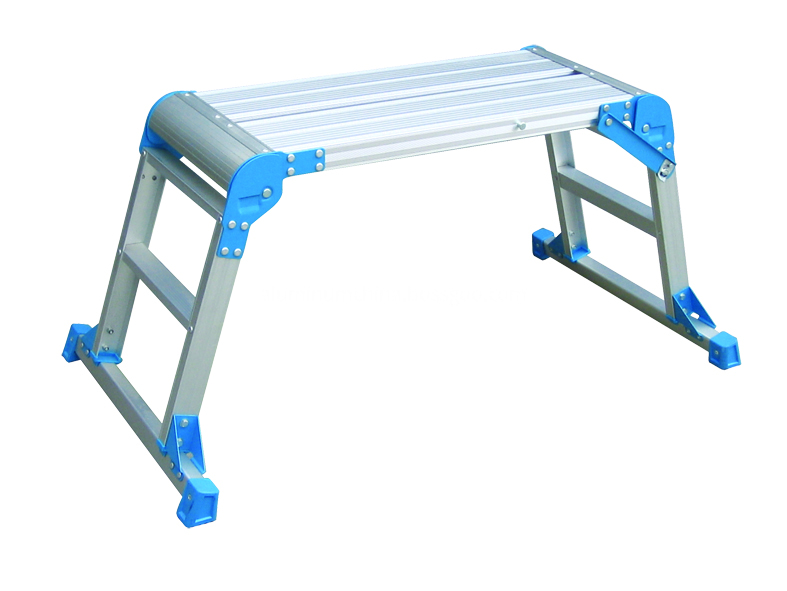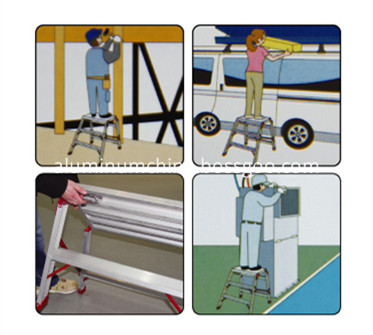Aluminum platform is a designed according to
EN131 standard.
The components are
connected with the riveting process, which very is firm and safe.
It have a wider platform that you can stand
on it and you can put the tools you need on it, so it is possible to work
comfortable from side to side. Sets up easily and provides convenient mobility
for home and work, a good helper when you wash the windows and car.
En131 Standard Working Platform Aluminum Working Platform,Platform Step Ladders,EN131 Ladder SUZHOU RIZHONGTIAN ALUMINUM CO.,LTD. , http://www.alumi-china.com
Yesterday, Premier Wen Jiabao of the State Council presided over the State Council executive meeting to study and deploy further implementation of key industry adjustment and revitalization plans. "The results achieved so far are only preliminary and phased."
The State Council has given six solutions including strengthening domestic demand and optimizing industrial layout. Specific measures include continuing to implement the policy of replacing old appliances with the countryside and auto and home appliances, promoting the transfer of electronic information, light industry, textile and other industries to the central and western regions, and resolutely controlling the total production capacity of steel, cement, electrolytic aluminum, coke, calcium carbide and other industries. Wait.
The problem is still outstanding
"The implementation of the ten major industrial restructuring and revitalization plans has achieved remarkable results, and the economic operation has gradually improved." On January 28, the Ministry of Industry and Information Technology (hereinafter referred to as the "Ministry of Industry and Information Technology"), together with the State Council Research Office, held the top ten industrial adjustments in Wuhan. Liu Lihua, a member of the Party Committee of the Ministry of Industry and Information Technology, said at the Symposium on Revitalization Planning.
This is particularly evident in the automotive industry. Last year, domestically produced vehicles sold more than 13 million vehicles, a year-on-year increase of more than 46%, and surpassed Japan to become the world's largest auto producer, surpassing the US to become the world's largest new car market.
However, while the results are outstanding, some problems that could have been solved with the help of the crisis have not been well resolved. "For example, the non-ferrous metals industry, especially the electrolytic aluminum industry, has a serious overcapacity, and it still has not been resolved." A senior executive of Chinalco (hereinafter referred to as "Chinalco") told the "First Financial Daily".
In fact, the overcapacity of the electrolytic aluminum industry has not only been solved well, but has a further upward trend.
According to the "Non-ferrous Metals Adjustment and Revitalization Plan", as of the end of 2008, the capacity of electrolytic aluminum production has been built and under construction exceeds 18 million tons, and the consumption of the year was 12.6 million tons.
However, the latest data from the Ministry of Industry and Information Technology shows that the current electrolytic aluminum production capacity has reached 20 million tons, exceeding the demand of 7 million tons. Last year, China's electrolytic aluminum output was 12.99 million tons, an increase of 1%.
"Before the Top Ten Revitalization Plan was put forward, the national macro-adjustment has always been to solve the problem of overcapacity, and the economic crisis has further forced the country to solve this problem." The above-mentioned senior officials of Chinalco said, "But the state wants to maintain growth and protect employment. It is stable and does not solve this problem."
The central decision-making level has clearly noticed the problems behind these economic growth. At the Central Economic Work Conference held in December last year, the State Council placed the “adjustment structure†in a more prominent position.
Promote domestic demand
Overcapacity is just one of many problems. The problems of excessive dependence on exports, mergers and acquisitions, and small scale of special funds for technological transformation also restrict the healthy development of China's economy.
Among the six major measures, the State Council will be based on expanding domestic demand and consolidating key industries to stabilize and rebound. In order to expand domestic demand, the incentives originally proposed by the relevant industry revitalization plan will continue to receive state support.
The State Council yesterday stressed that it is necessary to continue to implement the old-for-new policy of home appliances to the countryside and automobiles and home appliances, expand the scope of subsidized products, and support the demonstration and promotion of new energy vehicles.
In order to better expand domestic demand, the optimization of industrial layout was ranked second in the measures by the State Council. The State Council stresses that it is necessary to strictly enforce market access, strengthen investment management, and make an orderly transfer. Construction of advanced manufacturing bases and modern industrial clusters. Promote the transfer of electronic information, light industry, textile and other industries to the central and western regions.
Compressing and diverting excess capacity in the third measure will help optimize the industrial layout. The main industries with overcapacity are steel, cement, electrolytic aluminum, coke, calcium carbide and so on. “The steel industry will mainly carry out strategic layout to the coast in the future.†Wu Xiwei, consultant of China Iron and Steel Association, told this newspaper.
Overcapacity is largely due to the low concentration of the industry. Taking the steel industry as an example, due to the large number of domestic steel companies, in recent years, the international iron ore giants have been greatly threatened by price increases. Although the State Council proposed to promote mergers and acquisitions, industrial concentration and competitiveness of enterprises in the fourth initiative, "but the policy issues that restrict mergers and acquisitions have not been resolved." Luo Bingsheng, vice president of China Iron and Steel Association, told this newspaper. .
The State Council finally emphasized that it will strengthen technological transformation in key areas and important links, deepen reforms and study and establish institutions and mechanisms to promote adjustment of structure and transformation of development methods.


Six measures of the State Council consolidate the industrial restructuring and revitalization
About a year after the launch of the adjustment and revitalization plans for the top ten industries such as automobiles and steel, the decision-making layer hopes to increase its efforts.